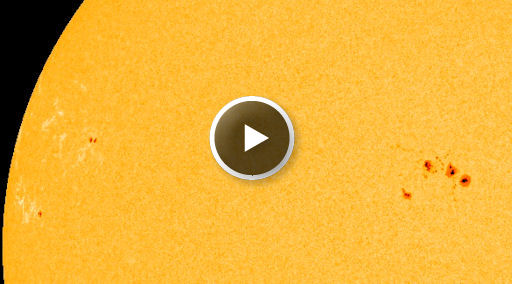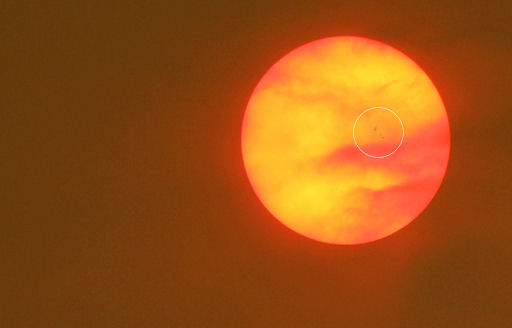They came from outer space--and you can have one! Genuine meteorites are now on sale in the Space Weather Store. | | |
AURORA WATCH: Earth is entering a minor solar wind stream that could stir up geomagnetic activity around the Arctic Circle. Sky watchers at high latitudes should be alert for auroras. Aurora alerts: text, voice.
SHAPE-SHIFTING SUNSPOT: Every time you look, sunspot 1271 has a new outline. For the past two days the active region has been in a constant state of change, altering its shape on an hourly basis. Click on the image for 48 hours of shape-shifting:

These rapid changes have caused the sunspot's magnetic field to criss-cross and tangle. The magnetic field now has a "beta-gamma" configuration that harbors energy for M-class solar flares. Any such flares today would be approximately Earth-directed because the sunspot is not far from disk-center.
Sunspot 1271 is so big, it's catching the attention of observers unaided by solar telescopes. Sarah E. Baur of Anaconda, Montana, noticed it yesterday through the smoke of a nearby fire:

"Our small town was inundated with smoke from surrounding forest fires," says Baur. "At 6:30 pm the sun appeared in and out through the thick smoke making a great photo op. I realized after viewing the shots on my monitor that sunspot 1271 is also visible."
more images: from Isabell Lembke of the Netherlands; from Enrico Perissinotto of Premariacco - Italy; from Craig & Tammy Temple of Hendersonville, TN; from Guenter Kleinschuster of Feldbach, Styria, Austria; from Ron Cottrell of Oro Valley, Arizona; from Francesc Pruneda Agusti of Palamós, Catalonia, Spain
August 2011 Aurora Gallery
[previous Augusts: 2010, 2009, 2008, 2007, 2006, 2005, 2004, 2003, 2002]
2011 Noctilucent Cloud Gallery
[previous years: 2003, 2004, 2005, 2006, 2007, 2008, 2009]
Potentially Hazardous Asteroids (
PHAs) are space rocks larger than approximately 100m that can come closer to Earth than 0.05 AU. None of the known PHAs is on a collision course with our planet, although astronomers are finding
new ones all the time.
On August 23, 2011 there were 1241 potentially hazardous asteroids.
Notes: LD means "Lunar Distance." 1 LD = 384,401 km, the distance between Earth and the Moon. 1 LD also equals 0.00256 AU. MAG is the visual magnitude of the asteroid on the date of closest approach. | | The official U.S. government space weather bureau |
| | The first place to look for information about sundogs, pillars, rainbows and related phenomena. |
| | Researchers call it a "Hubble for the sun." SDO is the most advanced solar observatory ever. |
| | 3D views of the sun from NASA's Solar and Terrestrial Relations Observatory |
| | Realtime and archival images of the Sun from SOHO. |
| | from the NOAA Space Environment Center |
| | the underlying science of space weather |
| | for out-of-this-world printing and graphics |

